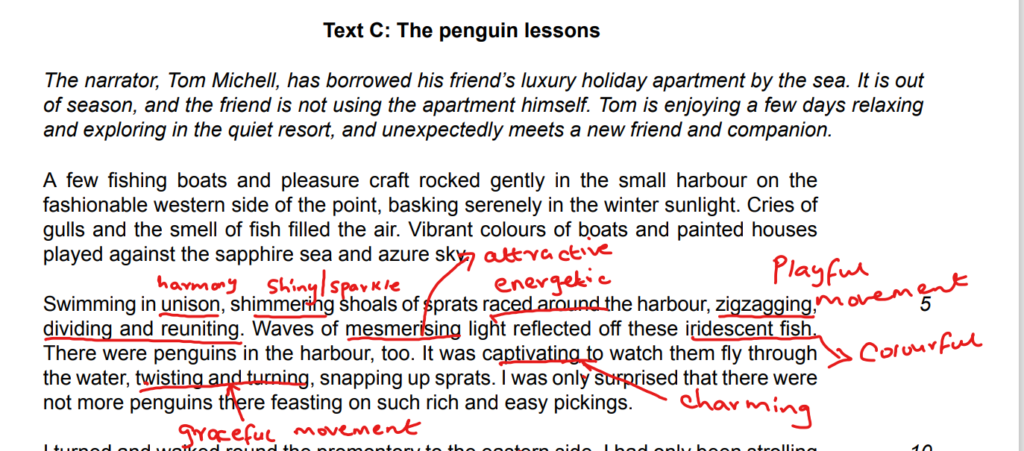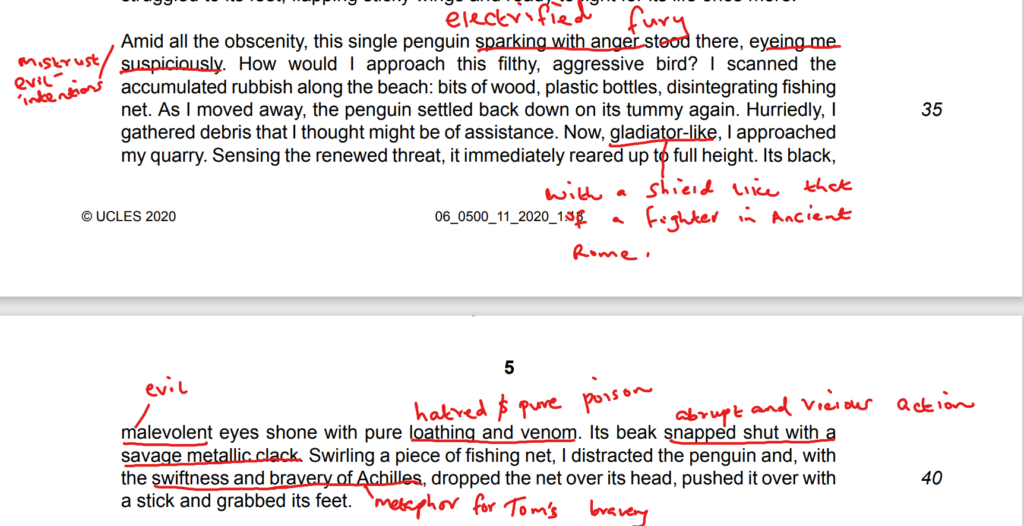
THE WRITER’S EFFECT QUESTION
The writers effect question tests your language analysis skills.
You are expected to read Text C and then re-read two specific paragraphs from the given passage.
From these paragraphs, you should select powerful words and phrases that the writer must have used to achieve particular effects. Remember that, your choices should include imagery.
You should be ambitious in your selection of words and phrases. However, it is important that you choose vocabulary that you can comfortably analyse. However, if a word seems foreign to you, try to figure out its contextual meaning, and that may just save you.
It is important that for each of your language choices, you clearly outline both the explicit and implicit meanings as well as how the writer influences the readers.
Your analysis for both paragraphs should average 200-300 words and must be written in the continuous form.
Explicit vs implicit information.
Explicit information refers to the surface ideas that are easy to understand without any ambiguity. When analysing the writer language, explicit meaning simply refers to the dictionary, literal and surface meaning of a word.
Example 1: John hurled the luggage.
The powerful verb ‘hurled’ means that the person he threw the luggage with great force.
Example 2: The fish swam in unison
The noun unison means that the fish swam in harmony and perfectly synchronized.
Implicit information on the other hand refers something that is suggested or implied hence not expressed directly. When analysing language, this simply refers to the suggested ideas by the writer. The writer did not directly express the idea, but they implied it by the language used.
Example 1: John hurled the luggage.
By using the powerful verb hurled, the writer implies that John was very angry or probably annoyed.
Example 2: The fish swam in unison
By using the powerful noun unison, the writer implies that the creatures’ movement looked like a performance and a true beauty to watch.
HOW TO WRITE THE OVERVIEW OF A PARAGRAPH.
An overview is the general impression/effect of the language created by the specific paragraph. This helps show the examiner that you clearly understand the effect the writer is trying to achieve in that paragraph.
- Always begin by reading the whole text to get a gist of the entire narrative
- Re read the two paragraphs as instructed in the question.
- Keenly read the information given about the paragraphs, in the question. The question will always look like this…… re read paragraph 2, begins ‘swimming in unison…’ and it is about the wildlife in the harbour.
- That bit on ‘what the paragraph is about’ should help you come up with an overview of the paragraph.
- The overview should not be a replica of what the paragraph is about. It should be descriptive of the kind of setting created such as eerie, romanticized, dramatic, threatening, welcoming, hostile etc.
- Example 1: Read Paragraph 5 beginning ‘Just before 7.30…’ and is about the dining room at the inn. (It means that your overview should focus on the kind of dining room it was, eg… unwelcoming, cold, old fashioned etc)
- Example 2: Read paragraph 2, beginning ‘swimming in unison…’ and is about the wildlife in the harbour. Then you should ask yourself, what kind of wildlife is it? Beautiful, threatening, romanticised etc.
- A sample template for an overview should look like this: The general effect of the language created in paragraph x is that of a romanticised and enticing view of the wildlife in the harbour.
IMPORTANT TIPS WHEN SELECTING WORDS AND PHRASES
- Your overview/general effect dictates the kind of language choices you should opt for. For instance, an overview about a romanticized view should focus on words and phrases such as captivating, shimmering, sparkling e.t.c.
- Only go for single words if they are powerful enough to serve as an independent analysis. Otherwise, short phrases are preferable.
- Don’t go for sentences, instead go for short phrases that are imbedded in the context.
Eg. Instead of writing…
The writer uses the phrase ‘it was captivating to watch them fly through the water, twisting and turning’
Say this instead:
The writer describes the movement of the sea creatures as ‘twisting and turning’
4. Always show an awareness of explicit meanings of your language choices before exploring the effects achieved. For powerful words, I would advise that you offer their literal/dictionary meaning. As for phrases and techniques, zoom into key words and explain their contextual meanings.
5. If you choose a phrase containing more than one powerful words, make sure that you interact and zoom into all of them and give their meanings.
Eg. a phrase like the lights flickered spasmodically, you need to zoom into the meanings of both flickered and spasmodically
6. For each language choice, interact with it fully and aim at saying at least 2 things about it using the zooming in technique. These two things can simply be the explicit and implicit meaning.
7. Use of connectives can help organize your ideas in a more coherent manner.
STRUCTURING YOUR RESPONSE
- As discussed earlier, each of the paragraphs being analysed should begin with an overview.
- After that, choose words and phrases that are relatable to the overview. Remember to annotate the meanings of these words and phrases in the text.
- Next, follow the PEMIL acronym to analyse each of the language choices (word, phrase or technique).
P-POINT BEING MADE
E-EVIDENCE (in quotes)
M-MEANING (explicit)
I-IMPLICIT MEANING
L-LINK TO THE OVERVIEW.
NB: your implicit meaning could also be considered as linking. As long as you clearly show how the suggested idea links back to your overview.
HERE IS A SAMPLE TEMPLATE
The general effect of the language created in paragraph x is that of….
The writer begins by using the powerful verb ‘insert language choice’……
Moreover, the writer uses the phrase ‘insert language choice.’
Finally, the writer uses the simile ‘insert language choice’ to
SAMPLE RESPONSE
Re-read paragraphs 2.
- Paragraph 2 begins ‘Swimming in unison ’ and is about the wildlife in the harbour.
Explain how the writer uses language to convey meaning and to create effect in these
paragraphs. Choose three examples of words or phrases from each paragraph to support
your answer. Your choices should include the use of imagery.
Write about 200 to 300 words.

How to answer the question
Begin by identifying the overview. Considering that the question states that the paragraph is about the wildlife in the harbour, then the overview should revolve the impression given by these creatures.
Next, identify words and phrases related to the overview.
Finally, use PEMIL to analyse these language choices and remember to link them to the overview.
SAMPLE RESPONSE 1.
The general effect of the language in paragraph 2 is that of a romanticized and beautiful view of the creatures in the harbour.
The writer begins by using the phrase ‘swimming in unison’ to show the movement of the sea creatures. The powerful noun unison means that the creatures swam in harmony and perfectly synchronized. The writer implies that the simultaneous movement seemed like a performance and a true beauty to watch.
The writer then uses the imagery ‘waves of mesmerising light reflected off these iridescent fish’ to describe the effect of the light on the fish. Iridescent refers to something that sparkles while mesmerizing denotes something enchanting and captivating. The writer suggests that the sun’s light is attractive and playful on the sea creatures thus romanticizing the sight to something one would love to watch.
Finally, the writer describes the movement of the sea creatures as ‘twisting and turning.’ The writer uses alliteration to denote the ease of movement through the water. To the reader, it suggests that the creatures moved in a graceful and athletic manner that was indeed spectacular and eye catching.
KEY:
BLACK – This is the overview of the paragraph
RED- This is the point being made together with the evidence
WHITE- This is the explicit meaning
PURPLE – This is the implied meaning alongside the linkage to the overview.
SAMPLE RESPONSE 2
Re-read paragraphs 9.
- Paragraph 9 begins ‘Amid all the ’ and is about approaching and capturing the bird.
Explain how the writer uses language to convey meaning and to create effect in these
paragraphs. Choose three examples of words or phrases from each paragraph to support
your answer. Your choices should include the use of imagery.
Write about 200 to 300 words.

How to answer the question
Begin by identifying the overview. Considering that the question states that the paragraph is about approaching and capturing the bird, then the overview should revolve the impression given by these bird as well as the person approaching this bird.
Next, identify words and phrases related to the overview.
Finally, use PEMIL to analyse these language choices and remember to link them to the overview.
SAMPLE RESPONSE 2
The general effect of paragraph 9 is that of a potentially dangerous bird and the bravery of Tom its rescuer.
The writer begins by using the phrase ‘sparking with anger’ to describe the penguin’s emotions. The word sparking could mean that the bird was burning with fury. It could imply that the penguin was ready for a fight, dangerous and potentially fatal to anyone who touched it. The writer then uses the phrase ‘swiftness and bravery of Achilles’ to describe Tom. Tom’s agility and bravery has been likened to the strong and courageous mythical Greek warriors. The writer sarcastically suggests that Tom was a hero ready to save the penguin despite the lurking danger that faced him. Finally, the writer mentions how the penguin’s eyes as ‘loathing and (with) venom.’ The word loathing means that the eyes were filled with disgust and dislike while venom denotes something poisonous. The writer implies that the bird ready for an attack clearly indicating how dangerous the penguin was.
Parting Shot
Mastering the art of answering the writer’s effect question requires regular practice. This will aid in improving your ability to analyse and interpret different descriptions.